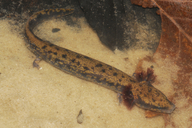|
Necturus lewisi Brimley, 1924
Neuse River Waterdog | family: Proteidae subfamily: Necturinae genus: Necturus |
 © 2023 Kevin G. Hutcheson (1 of 4) |
|
|
|
Description Distribution and Habitat Country distribution from AmphibiaWeb's database: United States U.S. state distribution from AmphibiaWeb's database: North Carolina
Life History, Abundance, Activity, and Special Behaviors Trends and Threats Relation to Humans Comments This species was featured as News of the Week on 8 October 2018: Amphibians have some of the largest and smallest known genomes of all tetrapods. Liedtke et al. (2018) shows that, although genome size is incredibly variable across amphibians, the majority of amphibian genome size evolution has occurred gradually over time. The best supported evolution model for genome size shows a single jump in size occurring as genome size increased in the ancestor of salamanders. Salamanders have the largest amphibian genomes, with the Neuse River Waterdog (Necturus lewisi) holding the title for largest tetrapod genome size (140 pg)! Furthermore, they found no support for the hypothesis that amphibian genome size evolves in association with changes in development (shifts such as changes from larval to direct development) but did see an association between genome size and length of development and climate (temperature and humidity). Despite amphibians having the widest range of tetrapod genome sizes, the evolution of genome size in this group can be largely explained by random, gradual change over time and appears to have little to do with the drastic changes in development that have repeatedly evolved within amphibians (Written by Molly Womack).
References
Ashton, R. E., Jr. (1985). "Field and laboratory observations on microhabitat selection, movements, and home range of Necturus lewisi (Brimley)." Brimleyana, 10, 83-106. Ashton, R. E., Jr. (1990). ''Necturus lewisi Brimley. Neuse River Waterdog.'' Catalogue of American Amphibians and Reptiles. Society for the Study of Amphibians and Reptiles, 456.1-456.2. Ashton, R. E., Jr., and Braswell, A. L. (1979). ''Nest and larvae of the Neuse River Waterdog, Necturus lewisi (Brimley) (Amphibia: Proteidae).'' Brimleyana, 1, 15-22. Braswell, A. L., and Ashton, R. E., Jr. (1985). ''Distribution, ecology, and feeding habits of Necturus lewisi (Brimley).'' Brimleyana, 10, 13-35. Cooper, J. E., and R. E. Ashton, Jr. (1985). "The Necturus lewisi study: Introduction, selected literature review, and comments on the hydrologic units and their faunas." Brimleyana, 10, 1-12. Guttman, S. I., Weigt, L. A., Moler, P. E., Ashton, R. E., Jr., Mansell, B. W. and Peavy, J. (1990). ''An electrophoretic analysis of Necturus form the southeastern United States.'' Journal of Herpetology, 24(2), 163-175. Neill, W. T. (1963). "Notes on the Alabama waterdog, Necturus alabamensis Viosca." Herpetologica, 19, 166-174. Petranka, J. W. (1998). Salamanders of the United States and Canada. Smithsonian Institution Press, Washington D.C. and London. Originally submitted by: Meredith J. Mahoney (first posted 2000-07-26) Edited by: M. J. Mahoney, Ann T. Chang (2019-03-06) Species Account Citation: AmphibiaWeb 2019 Necturus lewisi: Neuse River Waterdog <https://amphibiaweb.org/species/4225> University of California, Berkeley, CA, USA. Accessed May 27, 2025.
Feedback or comments about this page.
Citation: AmphibiaWeb. 2025. <https://amphibiaweb.org> University of California, Berkeley, CA, USA. Accessed 27 May 2025. AmphibiaWeb's policy on data use. |



 Raffaëlli Account
Raffaëlli Account Map of Life
Map of Life